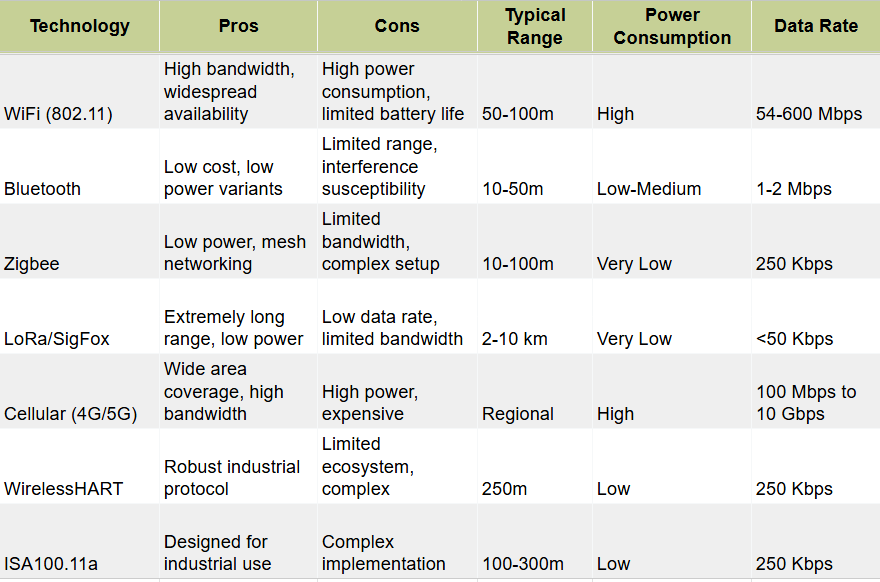FEBRUARY 26, 2025
Choosing the Right Wireless Technology for Industrial Condition Monitoring
KULDEEP AMARNATH, CEO @ PETASENSE

Introduction
As industries increasingly embrace Internet of Things (IoT) technologies for condition monitoring, the selection of an appropriate wireless communication technology has become a critical factor in the success of projects. Wireless communication in IoT-based industrial condition monitoring enables cost-efficient solutions and significant improvements in coverage and reach.
However, the wide array of choices, such as LoRa, Cellular, WiFi, Bluetooth, Zigbee, ISA100, and WirelessHART, can make the decision overwhelming. The right wireless solution can be the difference between a robust monitoring system and one plagued by connectivity issues, high costs, and limited performance. This article aims to explain the different considerations while choosing a wireless technology.
Considerations in Wireless Technology Selection
Selecting a wireless technology for industrial vibration monitoring is a multifaceted decision involving numerous technical and operational factors. Depending on your specific situation and constraints, some factors can play a more significant role than others. Some critical considerations in making an informed choice are:
1. Range and Coverage
Range is a key factor in selecting the right wireless technology for your operations. The effective communication distance between sensors and receiving infrastructure varies significantly across different wireless technologies from a few tens of meters with Bluetooth to several kilometers with Lora or Cellular. Industrial environments with large machinery and complex or dense layouts demand careful evaluation of signal propagation capabilities. Consider obstacles such as pipes, vessels, walls, and beams, which can affect signal propagation. Additionally, range has an impact on cost in terms of the number of access points (AP) or repeaters needed for desired coverage. The shorter the range, the more wireless networking hardware is required for reliable communication. The other consideration here is the location of access points or gateways. Cellular, for example, while exhibiting ranges of several km might not be a good choice if the monitored assets are located underground or in metal sheds as is the case with many installations.
Another related factor is wavelength. Most industrial communication technologies make use of frequencies in the ISM bands (“industrial, scientific, and medical “) which are generally centered around one of 868 MHz, 915 MHz, 2.4 GHz or 5.8 GHz. (except Cellular which has its own dedicated bands across a wide spectrum). While higher frequencies can carry higher data rates, the coverage in dense industrial environments is better with lower frequencies (higher wavelengths) for a given RF power budget due to less shadowing. Shadowing is caused by the signal being blocked or attenuated by obstacles in dense industrial environments, resulting in poor signal strength. Table 1 shows the free-space range of common wireless technologies.
2. Energy Consumption and Battery Life
Battery life represents a critical parameter in wireless sensor deployment strategies. Battery-operated sensors require minimal energy consumption to ensure extended operational periods without frequent maintenance interventions. Calculating total energy consumption or battery life is a fairly complex endeavor due to its dependence on multiple factors:
a. Radio Protocol and Power Consumption: The choice of radio protocol and its RF power play a critical role; for instance, LoRa typically offers low power consumption but with a limited data rate, whereas cellular solutions, despite a similar range, demand significantly higher power to support much higher data rates. Power also depends on range—longer distances generally require higher transmission power.
b. Duty Cycle: Some protocols require sensors to transmit or receive at frequent intervals to maintain the network, even when no data is being exchanged. For example, WiFi and mesh networked systems require frequent responses from client devices to regularly transmitted beacons (~100 ms) to maintain the network. One way to optimize this is to disconnect from the network when not in use and re-establish the connection only when transmitting data. This reduces power consumption but increases latency, creating a tradeoff between energy efficiency and communication speed.
c. Regulatory Power Limits: Wireless devices operating in ISM bands are subject to regulatory restrictions on maximum transmission power. These limits vary by region and frequency band, impacting range and overall network design.
d. Network Architecture:
Networks are typically structured as either ‘Star’ (clients communicate to a central Access Point) or ‘Mesh’ types (client nodes communicate to peers that relay data to a gateway). Mesh networks provide redundancy but require devices to frequently transmit and receive network maintenance information, increasing power consumption, especially for nodes near the gateway, which must relay data for multiple devices.
The best way to evaluate a protocol is to start with gathering info on how much data needs to be transmitted from a sensor, how frequently it needs to be sent, what latency is acceptable, and what range is required depending on locations of access points or peers. Then calculate the total transmit / receive time and power needed to exchange the data including any overhead such as establishing connections and taking into account protocol requirements. A typical triaxial vibration sensor transmitting full waveforms for PdM usage might need to send about 250 KB of data 4 times a day. Calculating and comparing energy consumption across wireless technologies can be complex. However, this analysis provides a solid technical foundation for informed decision-making.
3. Industrial Environment Performance
Wireless technologies must demonstrate exceptional resilience in challenging industrial environments. Metallic structures generating reflections or shadowing, high electromagnetic noise, extreme temperature variations, lack of line-of-sight, and persistent mechanical vibrations necessitate robust solutions that can handle these conditions.

The main factors that determine the reliability of networks in an industrial environment are architecture, wavelength, power, and any error correction built into the protocol. Mesh networks can provide redundancy in communication paths and are more resilient to any single point of failure. For Star networks, this has to be achieved through optimized repeater and AP placement. As mentioned earlier, longer wavelengths exhibit less shadowing and so tend to be more forgiving regarding client / AP placements. Error correction mechanisms, which automatically detect and correct data errors, add overhead in terms of energy usage and data rate but offer additional reliability in noisy environments.
4. Data Volume Requirements
The data volumes generated by condition monitoring can vary widely. While simple temperature or pressure monitors may produce just a few bytes every few minutes, vibration monitoring can generate several hundred kilobytes every few hours. Vision based monitoring systems like Thermography can generate even more volumes. The chosen protocol should be able to accommodate these with sufficient room or margin for future additions.
One consideration worth mentioning in this regard is Edge Computing. Moving some of the compute and analysis to the edge where data is produced and transmitting only the outcomes of the analysis helps with reducing the data volume burden. The flip side of this is the additional complexity, cost and energy consumption of these devices, especially if they are battery operated.
5. Network Topology and Reliability
The underlying network architecture profoundly influences overall system reliability and performance. Star topologies offer straightforward, direct communication paths, while mesh networks provide redundant communication routes and enhanced fault tolerance. The number of required gateways and the network’s self-healing capabilities are critical considerations when selecting condition monitoring technology to monitor your assets.
6. Additional Key Factors
Beyond technical specifications, there are a few additional factors that must be considered while choosing a wireless network design.
One such consideration is existing site infrastructure. Many sites have pre-existing wireless networks such as ISA100, WiHart or WiFi and it might not make financial sense to go with a new network design even if it has obvious technical advantages.
Another consideration is future communication needs. What might be sufficient for today’s sensing and control needs might not be enough for tomorrow’s requirements. Data volume is likely to only go up with more automation, monitoring and IoT deployments. So this has to be taken into account while planning for a long term deployment.
Yet another overlooked consideration is maintenance and diagnostic capabilities. Some protocols require specialized hardware and support to be able to diagnose issues and debug network problems. Having to rely on external service providers or specialized equipment can create bottlenecks if a problem arises. This can be particularly problematic with proprietary protocols compared to those based on open standards.
Organizations will need to consider these factors as well when deciding on their ideal wireless technology.
Comparative Analysis of Wireless Technologies

WiFi as a Pragmatic Compromise
For many industrial vibration monitoring applications, WiFi emerges as a balanced solution that addresses multiple critical communication requirements. Its strengths include comprehensive data transfer capabilities that support high-resolution sensor information, widespread infrastructure availability that reduces deployment complexity, and performance characteristics well-suited to moderate industrial environments. Moreover, WiFi offers significant future compatibility, positioning organizations to leverage emerging technological advancements without requiring complete infrastructure redesign.
Another key benefit of WiFi is its versatility; it supports applications beyond sensing, providing a middle ground between specialized industrial protocols and general-purpose communication systems.
The technology’s versatility stems from its ability to provide a middle ground between specialized industrial protocols and general-purpose communication systems. WiFi networks can support high bandwidth requirements, integrate easily with existing IT infrastructure, and offer relatively straightforward expansion and maintenance paths.
While WiFi historically has generally not been considered as a battery friendly technology, this can be addressed in a couple of ways. One is optimized data transfer. Devices don’t have to be on all the time if the need is to transmit only a few times in a day. Data compression will also help to a great extent. Also, WiFi is a fast developing technology with more IoT device friendly and power efficient sub-protocols such as the 802.11ah, which was released recently.
Conclusion
Organizations considering wireless technologies for industrial condition monitoring should adopt a structured, methodical approach to technology selection and implementation. A comprehensive site survey should be conducted to map existing infrastructure, signal propagation characteristics, and potential communication challenges specific to the industrial environment.
Detailed modeling of communication requirements will help organizations precisely define their technical needs, including data volumes, latency tolerances, and reliability expectations. Pilot deployments provide invaluable insights, allowing teams to validate theoretical models and identify potential real-world implementation challenges before full-scale rollout.
Future scalability must be a central consideration in technology selection. The chosen wireless solution should not only meet current monitoring requirements but also provide flexibility to incorporate additional sensors, support emerging data sources like video or advanced diagnostic imaging, and adapt to evolving industrial monitoring strategies.
Developing comprehensive performance metrics is crucial for initial evaluation as well as ongoing optimization. These metrics should encompass not just technical parameters like signal strength and data transmission rates, but also operational considerations such as maintenance frequency, battery life, and overall system reliability.
By viewing wireless technology selection as a strategic initiative that balances technical capabilities with long-term operational goals, organizations can build robust vibration monitoring systems that deliver actionable insights, optimize maintenance, and drive continuous improvement in asset management.



 Thanks for subscribing - stay tuned for our next newsletter
Thanks for subscribing - stay tuned for our next newsletter